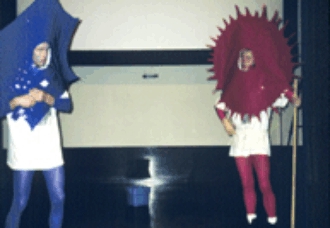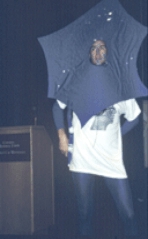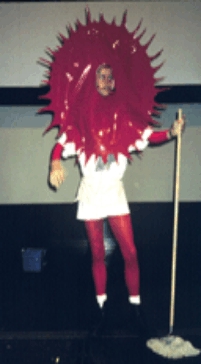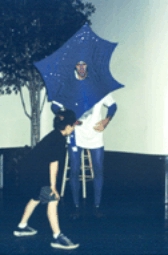The "Neuron & Glia" Play
In 1996 Tim Ebner and Robert Miller organized the first Brain Awareness Week (BAW) at the University of Minnesota. Unlike the annual BAWs that would follow, the first one involved a massive program for adults, faculty, undergraduates and K-12 students.
We brought the K-12 students onto the U campus where, in the Coffman Student Union, students rotated through displays and interactive demonstrations where they could learn something about their brains and brain function. From neuroanatomy to viewing scenes through reverse prisms, students had a rich variety of experiences which were focused on understanding the human brain.
To enhance the entertainment experience for the students, Miller wrote a play "Neuron and Glia" which was designed as an interactive experience primarily for the K-7 students. In this play a spinal cord motoneuron (played by a student studying acting), seemingly the king of the hill, trips over a glial cell (played by Miller's undergraduate student, Nathan Staff) and discovers that he doesn't know anything about glial cells and initially regards them as some kind of an inferior domestic cleaning person. But glia patiently walks Neuron through the many different things that glial cells provide and at each step the doubting Neuron has to be convinced that glial cells are important. In one of several examples, Neuron is denuded of his myelin sheath and then asked to witness what happens to his impulse conduction velocity by racing a group of students with and without the myelin sheath.

Figure 1 Neuron (left) meets Glia (right), somewhere deep in the spinal cord |

Figure 2 When Neuron first encounters Glia, he is doubtful about all the claims that Glia is making |
Each time a term such as myelin is introduced, a large card with the name "myelin" is marched across the floor and the announcer asks the children what form the insulating sheath around the nerve cell? The children all respond and shout "myelin." In this way many different terms such as potassium, epilepsy, neurotransmitters, saltatory conduction and myelin sheath were introduced and defined in an interactive way.

Figure 3 Glia begins to describe the many things he does which allow Neuron to function efficiently. The early description includes the mopping up of K+ |

Figure 4 Neuron waiting to race one of the students to show how fast the nerve impulse travels when the axon has a myelin sheath: neuron wins the race by jumping up in the air and turning around at the finish line and then asking the student what took him so long. Without the myelin sheath poor neuron couldn’t race very fast and the students always won. |
In addition to the costumes, the skit was surrounded by props, including a life size cardboard image of a Minnesota Timberwolves basketball player to illustrate how some neurons could have axons more than a meter in length. In the end Neuron and Glia walk off hand in hand with neuron convinced that he needs glia and swears to a life of affection and trust for his new found buddy. |
![]() Return
to: Dept. of Neuroscience : U of M Home
Return
to: Dept. of Neuroscience : U of M Home